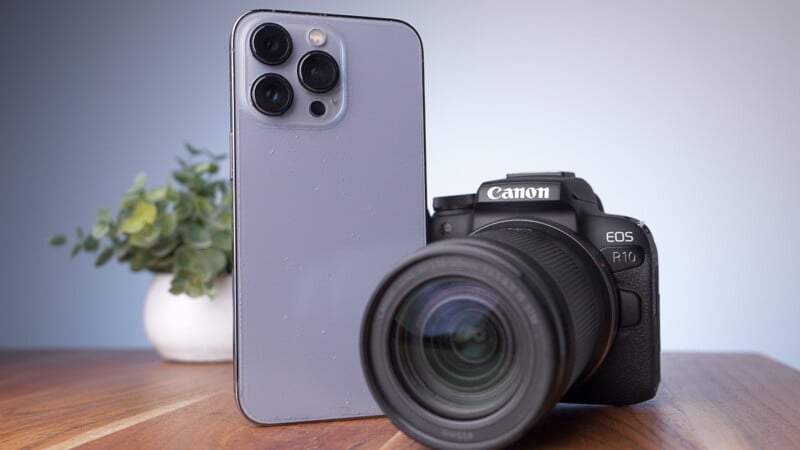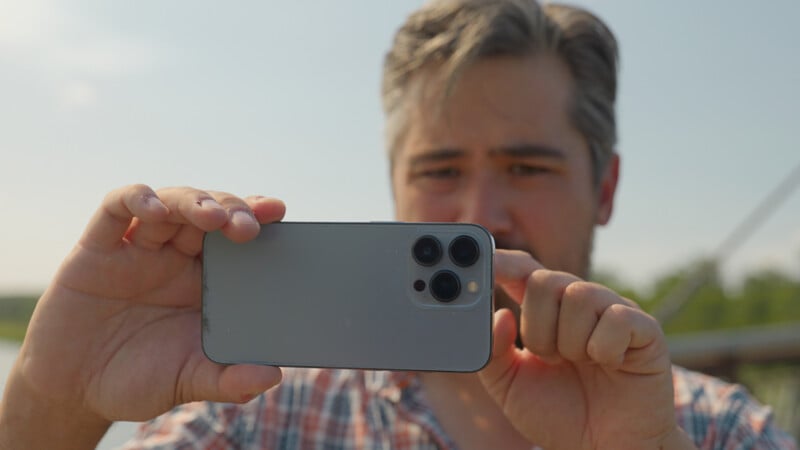It’s no surprise that smartphones have become the new everyday camera that we all use and love and they absolutely are legitimate creative picture-taking tools. So why even consider getting a more traditional camera with its bulkier size and expensive lenses?
You should definitely watch the video above to get the full story about all the benefits of upgrading to a more serious camera. However, below are the seven abbreviated reasons that a beginner should look at moving up, to whet your appetite.

At a Glance
Smartphones Have Poor Handling: It’s Like Taking Pictures With a Waffle
Smartphone handling is a chore when taking pictures. Holding a slim phone at arm’s length is hardly a stable platform. Although you can usually take pictures with a button on the side of the phone, any controls that need to be changed generally require dropping the phone from your current composition. Moving to a traditional camera will drastically improve the ergonomic situation in any picture-taking scenario.

Smartphone Displays Aren’t Ideal for Photography
Phone screens are literally brilliant in comparison to a traditional camera’s back screen. Maybe a little too brilliant. See, smartphones have amazingly vivid screens which look great when watching the PetaPixel YouTube channel but are not very accurate to the final result of the image.
They also don’t rotate without rotating the entire phone, which can make extreme-angle shots difficult to shoot. Cameras also usually have an EVF or electronic viewfinder, which is shielded from the sun on bright days and gives a gloriously accurate preview of your final shot.

Using a Flash with a Smartphone Isn’t a Good Experience
Phones have a built-in flash, but in reality, it’s just a flashlight. It pulses at the moment of taking the picture, but the quality and quantity of light are lacking. On a “real” camera you can utilize modern flashes that can provide way more power, or be used off-camera at interesting angles to create dramatic lighting. Now it is possible to take some nice shots with continuous LED lights and a smartphone, but you’ll never get the raw power that an electronic flash can provide.

Your Lens Options are Better with a Dedicated Camera
The modern smartphone has come a long way in providing multiple lens options for creative effects. However, they tend to be from an ultra-wide to fairly mild telephoto range and do not provide consistent image quality between the multiple lenses. One of the main benefits of an interchangeable lens camera is just that; interchangeable lenses. You can pick the ones that suit your work best, and reach out to extremes that a smartphone can’t touch. Whether it’s getting even wider, even closer, or even farther away, a camera can always outcompete a phone.

Smartphones Have to Fake Shallow Depth of Field
Having control over how much of your shot is in focus and what the relationship is between your subject and the background, is one of the main benefits of interchangeable lenses. Bright, wide-aperture lenses can be purchased to facilitate soft backgrounds that make your subject pop, or a subtle blur that tells the story without distractions. Smartphones can sort of mimic this with a selective digital blur, but the results aren’t always convincing. This fake effect will get better, but for now, the manual camera is king.

Cameras Still Win on Image Quality
A modern smartphone takes surprisingly good images. When it comes to low-light performance, dynamic range, and overall sharpness, the modern phone punch well above its weight. However, this capability is largely dependent on the phone being able to compile multiple images together every time the shutter is pressed.
When put into a situation like action photography where the phone might be moved rapidly, this ability to merge multiple images seamlessly is compromised. Phones are great picture-takers, but modern cameras still have the edge in most situations.
Smartphones Take Inferior Selfies
Who are we kidding? Modern photo-taking is all about selfies. I see so many people taking selfies with their smartphones with what happens to be the worst camera installed on the phone. I say, let’s all start shooting selfies on our more serious cameras. With many modern cameras incorporating articulating LCD panels and eye-detect autofocus, high-quality selfies are a snap to take.
You’ll love the quality over wheat you are getting out of your smartphone and it’s probably worth the immense hassle to then transfer the image to your smartphone to post on social media. Ok, maybe that whole process is still a win for smartphones, but the above six concepts are still plenty of reasons to look at a manual camera.
The Right Tool for the Right Job
In the end, it really comes down to what your goals and expectations are for your photos. Modern smartphones are very capable cameras and for some people, they might be all that’s needed. Poor ergonomics and a clunky interface to manually adjust pictures are the main reason I prefer to shoot on mirrorless interchangeable lens cameras instead.
Lens selection is a big one too. What really matters most though is whatever tool is going to make the most sense for how you want to be creative. Watch our episode to get far more information about why we think a more serious camera is a worthwhile endeavor.
"Smartphone" - Google News
August 15, 2023 at 09:02PM
https://ift.tt/mzCbGF4
7 Reasons To Use a 'Real' Camera Instead of a Smartphone - PetaPixel
"Smartphone" - Google News
https://ift.tt/VsRTPt2
https://ift.tt/cyGjDfh
Bagikan Berita Ini














0 Response to "7 Reasons To Use a 'Real' Camera Instead of a Smartphone - PetaPixel"
Post a Comment